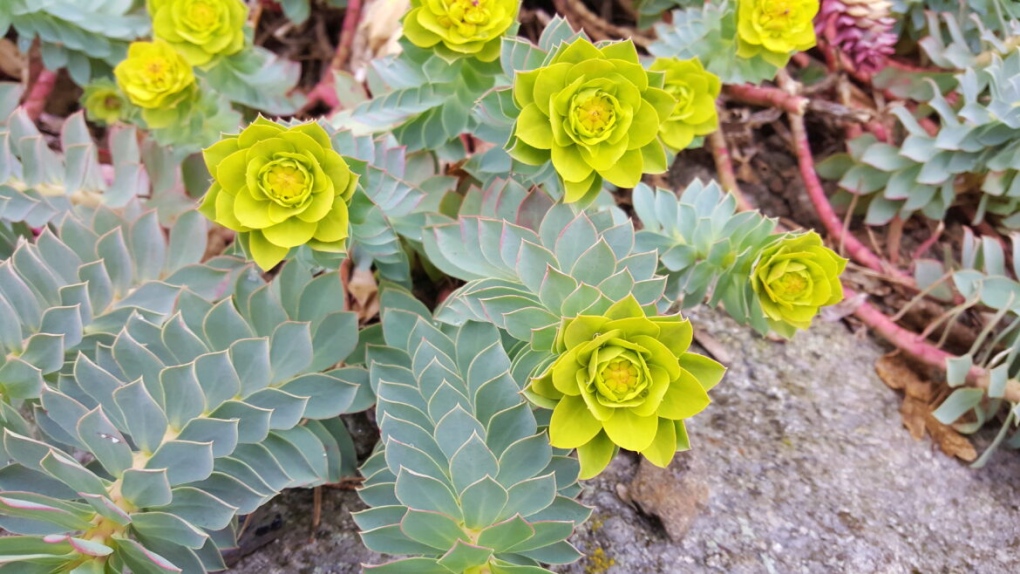Myrtle spurge: B.C. children left burned by invasive plant
 Two children suffering from the effects of Myrtle spurge contact are seen in an image from the Invasive Species Council of B.C.
Two children suffering from the effects of Myrtle spurge contact are seen in an image from the Invasive Species Council of B.C.
The Invasive Species Council of B.C. is asking the public to report sightings of a "highly toxic" plant that can leave people's skin blistered and burned – something one family recently learned the hard way.
Okanagan residents Doug and Sandra Nimmo were hosting their granddaughters over the July long weekend when the children came into contact with Myrtle spurge, a garden perennial that carries a nasty sap capable of causing blindness in severe cases.
Fortunately, the children, who had been picking plants for a bouquet, only woke up the next morning with red and irritated skin, according to the Invasive Species Council, which shared the family's story.
"They got out of bed, and I was shocked to see their faces puffed up with blisters," Sandra Nimmo told the ISCBC, adding that the children weren’t seriously hurt.
“They laughed when they saw their faces in the mirror, and it only took about a week and a half to clear their skin.”
Myrtle spurge, or euphorbia myrsinites, is described as an extremely aggressive invasive species from the Mediterranean that can quickly take over gardens and other green spaces.
If ingested, the plant can cause nausea, vomiting and diarrhea. To cause blindness, the sap has to come into contact with someone's eyes.
The Invasive Species Council said Myrtle spurge is recognizable by its small, yellow flowers and light blue-green leaves, which are sharp and spiral closely around the stem. The plant grows 10 to 15 cm tall and forms a "low, spreading mound," according to the ISCBC.
 Myrtle spurge is seen in an image from the Invasive Species Council of B.C.
Myrtle spurge is seen in an image from the Invasive Species Council of B.C.
The plants are mostly found in the Okanagan, where they thrive in its warm climate and dry soil. They’re also sometimes found for sale at garden centres, despite being provincially regulated.
"With our PlantWise program, we are working with growers, retailers, and consumers to spread the word about which invasive species shouldn’t be sold and grown in B.C.," ISCBC's Allison McCabe said in a statement. "Great alternatives to Myrtle spurge include Lanceleaf Stonecrop (sedum lanceolatum), a beautiful native succulent that thrives in hot, dry conditions.”
The Invasive Species Council of B.C. said people can find more alternatives through its Grow Me Instead website. Anyone who has been in contact with Myrtle spurge or another invasive species is urged to report it online.
CTVNews.ca Top Stories

Heavy snow, freezing rain warnings hit parts of Canada, expected to last throughout Monday
Significant snowfall and heavy rain hit parts of Canada on Sunday and the weather system is expected to continue into Monday morning and throughout the day.
The Canada Post strike involving more than 55,000 has hit 25 days
The Canada Post strike involving more than 55,000 workers has hit 25 days.
Most Canadians view illegal immigrant border crossings as concern for U.S.: Nanos survey
More than 80 per cent of Canadians believe the flow of illegal immigrants from Canada to the U.S. is a concern, according to a new survey.
Government faces third Tory non-confidence vote ahead of potential fiscal hurdle
The Liberals are set to face a third Conservative non-confidence vote today, but the government is likely to survive with the support of the NDP.
Jay-Z accused of sexually assaulting 13-year-old in 2000 incident along with Sean 'Diddy' Combs
A woman who alleges she was sexually assaulted by Sean 'Diddy' Combs has amended her lawsuit to include allegations that she was also assaulted by Jay-Z at the same party.
Suspect wanted after victim forcibly confined, assaulted, and threatened with death in Scarborough
Police have released images of an individual who allegedly forcibly confined, and assaulted and threatened to kill another person in southwest Scarborough over the weekend.
Who is Abu Mohammed al-Golani, the leader of the insurgency that toppled Syria's Assad?
Abu Mohammed al-Golani, the militant leader of the insurgency in Syria, has spent years working to remake his public image, renouncing to ties to al-Qaida.
Some cancer patients may forgo care due to high treatment-related costs: report
A Canadian Cancer Society report, published Monday in partnership with Statistics Canada and the Public Health Agency of Canada with analysis by Canadian Partnership Against Cancer, estimates a cancer patient will face almost $33,000 on average in out-of-pocket cancer-related costs in their lifetime, including loss of income.
'Polarization' is Merriam-Webster's 2024 word of the year
Merriam-Webster has named 'polarization' as its word of the year.






























